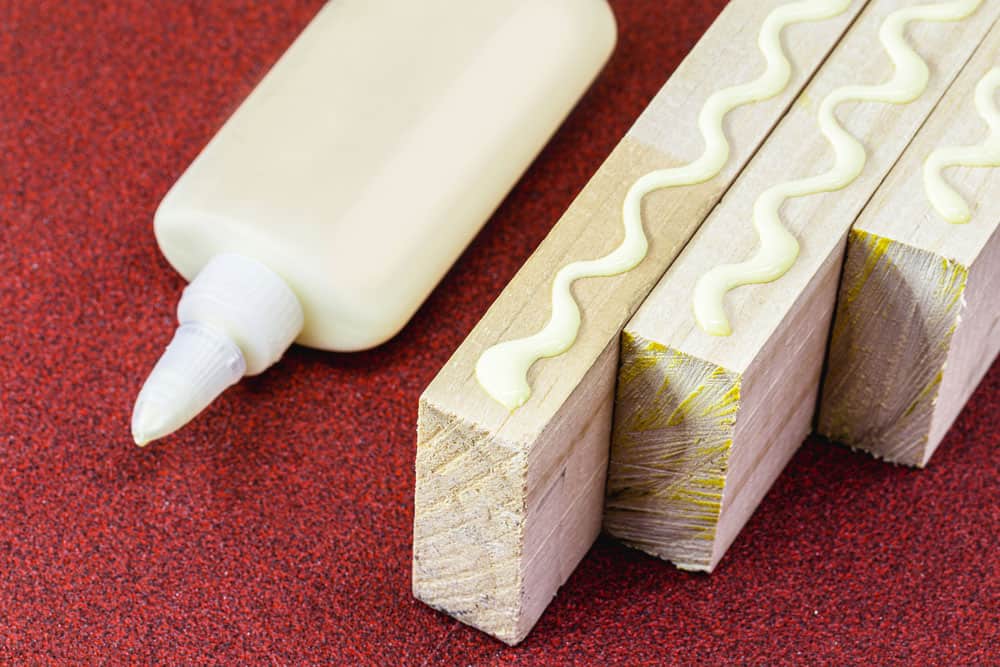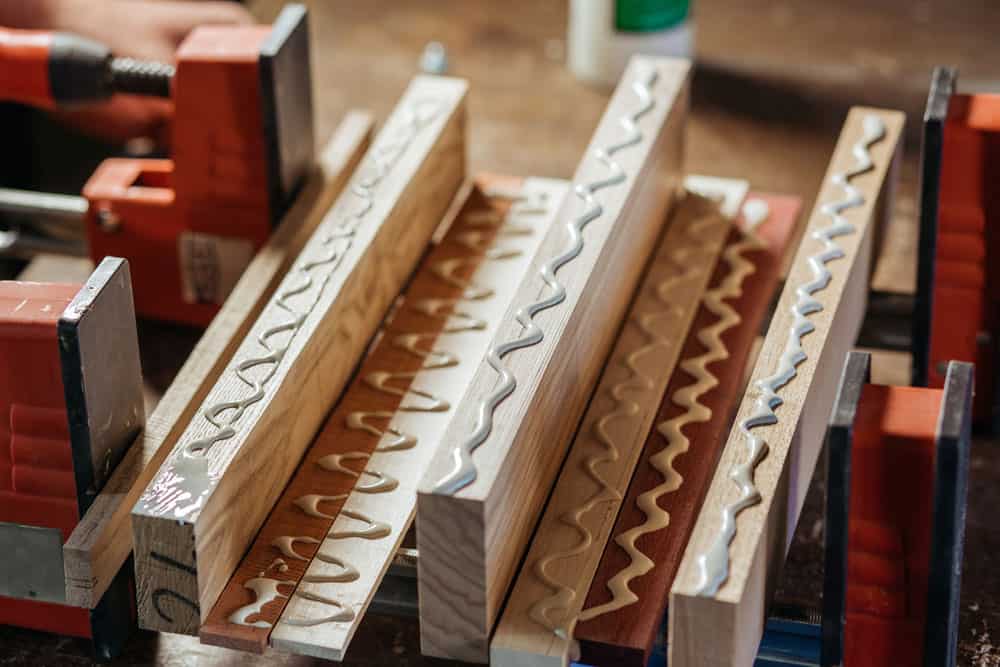If you’ve ever asked what is the best wood glue for cutting boards, this guide is for you!
Choosing the best wood glue for making a cutting board does not have to be complicated. The most important fact to consider is the safety of the glue for food processes.
In this post, you will find out the best wood glue for making cutting boards. We will also look at a few factors that affect the drying time of your wood glue.

Wood glue sandpaper concept carpentry
What Is The Best Glue For Cutting Boards?
A straightforward answer to this question is the good old Titebond III ultimate wood glue.
Titebond III is the first choice of about 90% of woodworkers for all its qualifying properties. It is the most widely used wood glue for cutting boards.
Titebond III is a polyurethane glue with superior bond strength. The waterproof formula passes the ANSI/HPVA Type I water-resistance specification.
It is FDA approved for indirect food contact, and above all, it has a relatively long open assembly time giving up to 25 minutes.
The next alternative to this glue is Titebond II, a close relative of Titebond III, bearing very close properties and giving similar results.
Titebond II is equally FDA-approved and safe for making cutting boards.
Important Factors To Consider When Choosing A Glue For Cutting Boards
Unlike other woodwork, making cutting boards are different because they come in contact with food. It is important to put a few factors under check before choosing wood glue for your cutting boards.
Food Safety
When choosing glue, it is essential to ensure it is FDA approved for indirect contact with food. However, the word to take note of is “indirect.”
This means that if found nontoxic after drying and curing, the substance may be safe for food preparation but never for consumption.
Water resistance
Cutting Boards are used for food preparations that involve a lot of moisture. Using wood glue that has high water resistance is essential to prolonging the duration of the cutting board.

Glue on pieces of wood left to dry
How Long Does Wood Glue Take To Dry
Wood glue drying time is dependent on a lot of factors. When working on wood, it’s important to observe the working condition and note how they affect your glue drying time.
This is essential because it contributes to the strength of your woodwork.
Ideally, wood glue binds within 25 to 30 minutes of application. At this stage, the wood is ready for other light works like sanding.
However, it takes about 24 hours for complete curing, at which point the bond is stronger than the wood.
The amount of glue applied can contribute to how long it takes for the glue to dry. The thinner the glue, the faster it takes to dry.
While many people believe that applying more glue increases the strength of the bond, the reverse is the case.
Thick layers of glue increase the drying time, thereby reducing the strength and effectiveness of the glue.
Similarly, clamps are not necessarily important when bonding wood together with glue. The water content of wood glue enables it to penetrate wood easily to form a strong bond.
However, glues might bond weakly with wood if the wood surfaces do not align perfectly due to cracks or bubbles. In this case, you can use a clamp to hold the wood in place until adequately attached.
A few other factors can contribute to the drying time of your glue. Here are some of the factors you must consider:

Bonding wood in the workshop
The type of glue
Some glue dries faster than others. This is simply a result of the formulation of the glue. It is important to read through the label of every wood glue you purchase to determine the manufacturer’s estimated drying time for the glue.
The temperature
The environmental temperature around your workshop contributes to how fast or how slow your wood glue dries after application.
Higher temperatures will decrease the drying time of your wood glue. This is because wood glue binds with the wood after the water content of the glue evaporates.
High temperature increases the speed of evaporation of water, thereby making the bond form faster.
The minimum temperature that enables appropriate drying of glue is about 10°C to 16°C (50°F to 60°F). Wood glue may not dry below this temperature.
The humidity
Wood Glue will take longer to dry in a very humid environment. Understanding that the liquid content of glue needs to evaporate for a bond to form, it is essential to allow a much longer time for your wood to dry when working in a humid environment.
The same applies to wet woods. Damp wood takes longer to bind than dry wood. This is because of the extra moisture of the wood. Ideally, it helps to put out a piece of wood to dry before working on it, especially if gluing will be involved.
Conclusion
Due consideration and care are necessary when choosing wood glue for your cutting boards. The best glue for cutting boards must meet the qualities stated in this blog post.
It must be safe for indirect contact with food and provides resistance to moisture.
